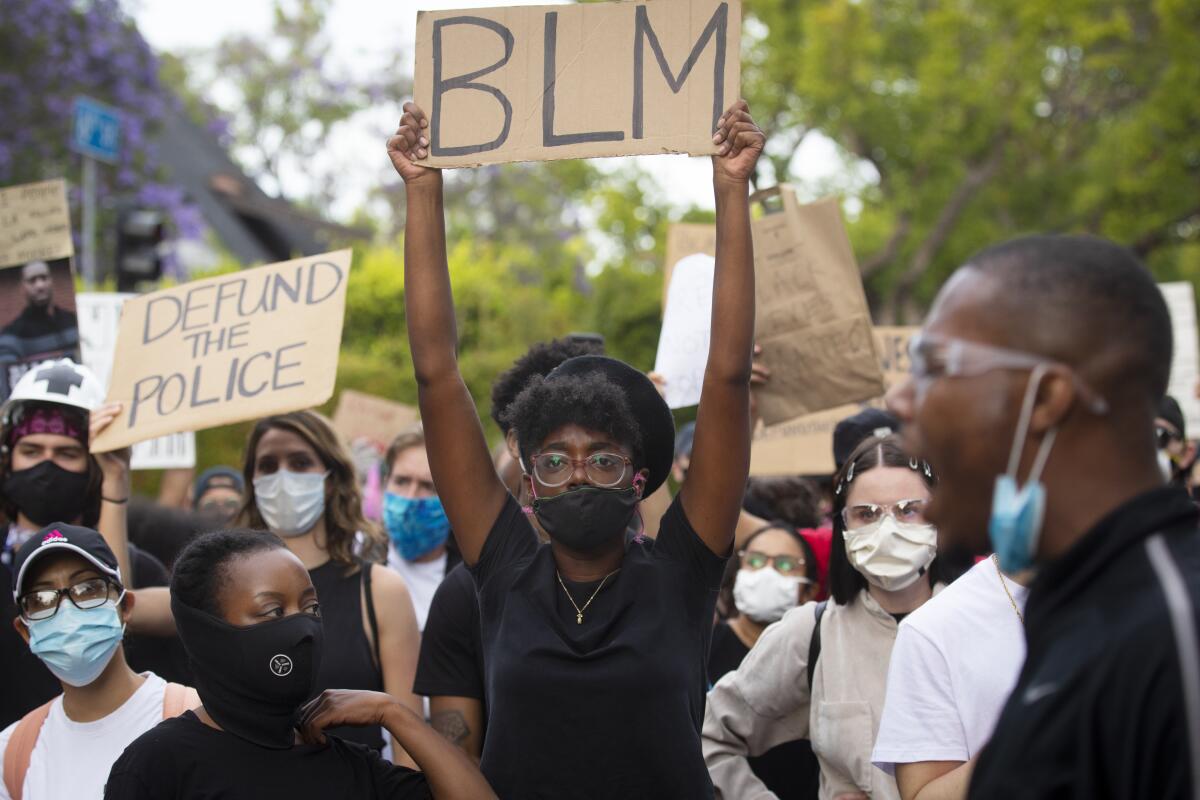Defund the police? L.A. needs to stop dodging the question

- Share via
In the weeks and months after George Floyd’s murder, activists coalesced around one terrible truth: Decades of police reforms have not stopped the targeting, abuse and unjust killing of people of color by police officers. Their answer was to call for more radical steps, starting with reducing the size, scope and budgets of law enforcement agencies. As protests spread across the country, so did the call to “defund the police.”
What exactly “defund the police” means depends on whom you talk to, but one common theme is this: Spend less on policing and more on services and programs that make communities safer. That message and the protesters behind it have forced a long-overdue and much-needed reexamination of policing in this country.
Local law enforcement agencies have become more militarized over the last three decades, even as police responsibilities have expanded into the domain of public and social services. Cities have police officers doing everything from checking subway fares to taking reports after car accidents. Officers are expected to do outreach and street counseling to homeless individuals. They’re summoned when a person is having a mental health crisis. They get called out to deal with fights at schools or disorderly students.
Those challenges have little or nothing to do with violent crime, and the defund movement has prodded communities to ask why an armed police force is being relied on to handle them.
The Times Editorial Board examines the reckoning of the last year and considers what it means for policing and protest in Los Angeles and elsewhere.
Police officers rarely have the training to respond appropriately to all manner of crises and social problems. And by relying on law enforcement to be the catch-all service provider, we run the risk of criminalizing activities and behaviors that are not crimes. Sending an officer to handle a misbehaving student increases the likelihood that the young person will end up in the criminal justice system. And sending an officer with a gun to deal with someone having a mental health crisis increases the chances that person will end up getting shot.
Even police chiefs have complained that their departments are asked to do too much (though few have called for their departments’ staffing and budget to be cut in response). In Los Angeles, Chief Michel Moore has said the vast majority of service calls related to homelessness and mental health are not criminal matters and could often be handled by a professional social worker. He figures the LAPD could divert more than 200,000 calls a year to agencies outside law enforcement.
Yet it’s not easy unwinding decades of overreliance on police. And it’s especially hard to talk about reducing police responsibilities when there’s an uptick in violent crime in some cities, including L.A. But if not now, when?
Just look at Los Angeles. Pushed by the protests last summer, Mayor Eric Garcetti and the Los Angeles City Council made national headlines with their promise to cut $150 million from the police budget and reinvest the money in the city’s disadvantaged communities of color (which ultimately received only a portion of the money). They also called for new programs to use unarmed civilian personnel for nonviolent 911 calls and traffic enforcement. Yet even as the city seeks to move some responsibilities away from the LAPD, the City Council just approved a 3% increase in the police budget and a hiring plan to replace the exodus of officers over the last year.
In reality, Garcetti and the council weren’t forced to make trade-offs this year. Thanks to a $1.3-billion infusion of federal relief dollars, the city can launch pilot programs to test alternatives to police response without having to shrink the police budget. The hard choices will come in future years, when city leaders will have to decide which programs to expand, maintain or end — and, more important, how to pay for them. L.A. spends about half of its unrestricted dollars on the Police Department. It’s difficult to see how the city can afford to create an entirely new civilian crisis response corps without touching the LAPD budget or asking voters to raise taxes.
Even cities with a full complement of unarmed responders still need police, and good policing isn’t cheap. It requires recruiting and paying the right people to be smart, resourceful, humane and level-headed officers. It requires ongoing training and supervision, along with continued investment in body cameras and other accountability technology. It means layers of oversight and compliance with open records laws. Transparency isn’t cheap either, but it’s essential.
But for too long the police have been treated as the primary remedy to public safety problems, and there’s been too little debate over what kind of service to expect and how it is to be delivered. In Los Angeles and other cities, that focus on the Police Department has come at the expense of other programs and services that could help address the root causes of crime, including poverty, joblessness and lack of opportunity.
The defund movement has rightly forced people to rethink policing. Now, civic leaders need the courage and political will to follow through with new approaches.
This editorial is the fourth in a series.
More to Read
A cure for the common opinion
Get thought-provoking perspectives with our weekly newsletter.
You may occasionally receive promotional content from the Los Angeles Times.










